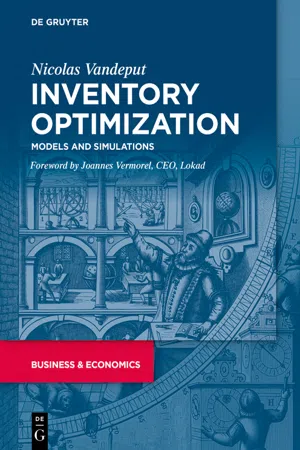
- 318 pages
- English
- ePUB (mobile friendly)
- Available on iOS & Android
About this book
In this book... Nicolas Vandeput hacks his way through the maze of quantitative supply chain optimizations. This book illustrates how the quantitative optimization of 21st century supply chains should be crafted and executed.... Vandeput is at the forefront of a new and better way of doing supply chains, and thanks to a richly illustrated book, where every single situation gets its own illustrating code snippet, so could you.
--Joannes Vermorel, CEO, Lokad
Inventory Optimization argues that mathematical inventory models can only take us so far with supply chain management. In order to optimize inventory policies, we have to use probabilistic simulations. The book explains how to implement these models and simulations step-by-step, starting from simple deterministic ones to complex multi-echelon optimization.
The first two parts of the book discuss classical mathematical models, their limitations and assumptions, and a quick but effective introduction to Python is provided. Part 3 contains more advanced models that will allow you to optimize your profits, estimate your lost sales and use advanced demand distributions. It also provides an explanation of how you can optimize a multi-echelon supply chain based on a simple—yet powerful—framework. Part 4 discusses inventory optimization thanks to simulations under custom discrete demand probability functions.
Inventory managers, demand planners and academics interested in gaining cost-effective solutions will benefit from the "do-it-yourself" examples and Python programs included in each chapter.
Events around the book
Link to a De Gruyter Online Event in which the author Nicolas Vandeput together with Stefan de Kok, supply chain innovator and CEO of Wahupa; Koen Cobbaert, Director in the S&O Industry practice of PwC Belgium; Bram Desmet, professor of operations & supply chain at the Vlerick Business School in Ghent; and Karl-Eric Devaux, Planning Consultant, Hatmill, discuss about models for inventory optimization.
The event will be moderated by Eric Wilson, Director of Thought Leadership for Institute of Business Forecasting (IBF):
https://youtu.be/565fDQMJEEg
Frequently asked questions
- Essential is ideal for learners and professionals who enjoy exploring a wide range of subjects. Access the Essential Library with 800,000+ trusted titles and best-sellers across business, personal growth, and the humanities. Includes unlimited reading time and Standard Read Aloud voice.
- Complete: Perfect for advanced learners and researchers needing full, unrestricted access. Unlock 1.4M+ books across hundreds of subjects, including academic and specialized titles. The Complete Plan also includes advanced features like Premium Read Aloud and Research Assistant.
Please note we cannot support devices running on iOS 13 and Android 7 or earlier. Learn more about using the app.
Information
Part I Deterministic Supply Chains
1 Inventory Policies
- Continuous review policies: an order can be made at any time.
- Periodic review policies: the orders can only be made at specific times.
1.1 Policy #1 – Continuous Review and Reorder Point





- When the stock level reaches 3 pieces, I order 10.Here the fixed reorder point is 3, and the order quantity is 10 (see Figure 1.1). Note that, even if you only have 2 pieces in stock, you will still only order 10 pieces. Remember: with the fixed reorder point, the order quantity (10 in this case) is always fixed.
- As soon as I am left with 2 bottles of milk in my refrigerator, I’ll go to the supermarket and buy 6.
- When my printer says that I am left with only 10% of ink, I’ll order a new set of cartridges.
Advantages
Limitations
Table of contents
- Title Page
- Copyright
- Contents
- Part I Deterministic Supply Chains
- Part II Stochastic Supply Chains
- Part III Advanced Stochastic Models
- Part IV Discrete Inventory Optimization
- Subject Index